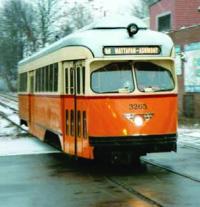January 13, 2016
 PCC trolley on the Mattapan lineHow long can the Commonwealth of Massachusetts keep the existing Mattapan High Speed Trolley Line running with its current fleet of classic but increasingly antiquated Presidential Conference Cars?
PCC trolley on the Mattapan lineHow long can the Commonwealth of Massachusetts keep the existing Mattapan High Speed Trolley Line running with its current fleet of classic but increasingly antiquated Presidential Conference Cars?
The answer is not yet certain, but it’s likely to come into sharper focus over the next year now that existential questions of transportation are being posed by members of Governor Baker’s MBTA Fiscal and Management Control Board.
On Monday, T officials briefed the board on the state of its vehicle fleets – 639 subway and trolley cars and 991 buses – that make up the MBTA system. In the larger scheme of things, the 10 PCC trolleys that run on the Mattapan Line constitute a fragment of the total picture, especially when weighed against the hundreds of Green Line vehicles, for example, most of which are in line for replacement.
According to an account of Monday’s presentation by the State House News Service, MBTA Chief Operating Officer Jeff Gonneville told the control board that the PCC cars – which first entered service in 1945 – are a challenge to the T’s coffers as well as to its employees, who literally have to manufacture replacement parts at the T’s Everett workshop.
"At times we actually need to reach out to trolley museums to get components and parts to be able to keep these vehicles in revenue service," Gonneville said.
Steve Poftak, a member of the control board who professes a fondness for the Mattapan trolleys and enjoys riding them with his children periodically, said that the novelty of keeping the vintage cars operational needs to be studied with a cold eye on costs.
“It’s not really clear how much we are spending crafting hand-built parts for the cars. If we get a forensic accounting of it, my suspicion is that it will be too much,” said Poftak. “I will change my mind when the data changes.”
Joe Pesaturo, a spokesman for the MBTA, told the Reporter this week that a “thorough analysis of the line's infrastructure and vehicles” will be completed this year.” It will include “options for the future, some of which were mentioned yesterday at the board meeting,” said Pesaturo, referring to ideas that were floated at the meeting, such as replacing the trolleys with buses. “As is always the case, the communities served by the line will play an important role in the public process of deciding how to best meet the area's transit needs.”
Even the hint of putting the PCC fleet out to pasture has sparked pushback on social media, with one rail buff launching a Save the Mattapan Line Facebook page. Is it too soon for all that? Perhaps, but it speaks to the special place the high-speed trolley line has in our community.
State leaders should know that they will face an uphill climb in these parts if their starting point on the subject is anything less than neutrality. The Mattapan trolleys are a unique and cherished part of our neighborhood’s daily life. And, for many thousands of people, they are still a convenient and efficient means of getting around. They also have historic value and enhance the quality of life in this community.
The costs of keeping these vintage cars on the tracks needs to be measured in more than just dollars and cents and timesheets.
Topics:


